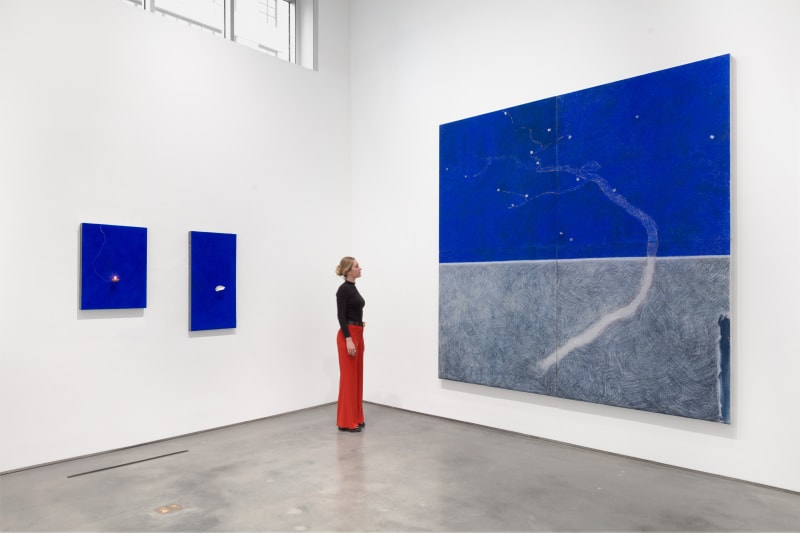BY OSMAN CAN YEREBAKAN
Two years after the death of art critic Germano Celant, who first coined the movement’s name, Arte Povera is making splashes in the city and beyond.
When Marianne Boesky decided to give Pier Paolo Calzolari his first New York exhibition in 25 years back in 2012, she was determined to reintroduce Arte Povera’s discreet maestro to the other side of the pond with a grand presentation. So much so that Boesky called Pace Gallery’s Marc Glimcher to blow holes in the walls between the two galleries for a sprawling joint exhibition offering an in-depth look at the artist’s material-rich practice in sculpture, painting and film. Boesky has recently opened Calzolari’s first exhibition in New York in five years at her eponymous gallery with a body of work the Lisbon-based Italian started creating right before the pandemic, as well as some historical paintings from his retrospective at Naples’s Madre museum in 2019.
Titled Painting as a Butterfly (until 23 April), the show celebrates the 79-year-old artist’s signature materials, including egg tempera, oil pastel, tempera grassa and salt along with a host of everyday objects poetically integrated onto wooden panels. As is typical of Arte Povera—the group of like-minded, materials-focused artists from post-Industrialist Italy who blew away the European art scene in 1960s and 70s—much of Calzolari’s work features curious, almost theatrical uses of mundane materials in conversation with rougher accents, such as the shells, feathers, dress or flowers paired with steel and iron in this show.
Calzolari entered Boesky’s orbit through another artist she represents, Jay Heikes, who raved to her about Calzolari’s works one day over lunch. The name was familiar, Boesky says, but she could not find any substantial English text on him and eventually wrote the artist a letter. Their initial encounter was a ten-hour studio visit at his Lisbon studio, Boesky says, yet she still had to chase him for representation—“in fact, I still have to chase him for a new show because he doesn’t let go of work easily”.
The critical and commercial response to their first collaboration was fueled by Calzolari’s key role in Arte Povera and his reputation as a prolific yet reticent artist. “People asked me how I’d price his work without much auction record,” Boesky says. “I had to remind people he’s embedded in art history and give collectors a certain confidence that this is an artist who has been working quite diligently for a very very long time.” Calzolari himself was not willing to start low either and wanted prices for his work to reflect his commitment and stature, “so we left the prices as he wanted, and let people come to the work with an understanding that it is not necessarily about the market or other people’s validation, but rather the value of the power of the art”.
Calzolari’s show is not the only evidence of Arte Povera’s enduring power in New York this season. Another member of the movement, Piero Gilardi, is the focus of a major upcoming survey at the Magazzino Italian Art centre in Cold Spring, New York. The artist’s first museum show in the US, Gilardi: Tappeto-Natura (7 May 2022 – 9 January 2023), was co-organised by curator Elena Re and Magazzino director Vittorio Calabrese and spans the Turin-based artist’s work from 1964 to two years ago, with a focus on the titular polyurethane carpets from the 1960s. Painted in bright colours, the carpets are hefty re-imaginings of nature scenes rendered in a highly industrial material with a dose of the trademark humour that is inherent to Arte Povera’s focus on the thin line between art and the everyday.
“There was not any industrial aspect in his process but rather Gilardi’s is a craftsmanship, each piece put together one by one,” says Calabrese, who notes the work’s democratic aspect. “He in fact cut out pieces from the carpets and sold them by the yard.” Although Gilardi is less widely recognised in the US than the movement’s marquee names like Giuseppe Penone or Michelangelo Pistoletto, he traveled to New York often in the 1960s as a reporter for Flash Art, lodging at the Chelsea Hotel. He also showed alongside many of the movement’s key members at the influential Sonnabend Gallery, and at Fischbach Gallery, where he had his first solo show in 1967. The same year, back in Italy, he modeled for one of Pistoletto’s iconic mirror works, Gilardi Assis. “He played a big role to inspire everyone to really think of them as a group,” Calabrese says. “With this show, we investigate him as a critical figure but also his story as a person while he turns 80 this year.”
Two gems in the show, both from 1967, are the wearable work Vestito-Natura Bettule, which Gilardi created for a happening at Turin’s legendary nightclub Piper, and Sassy (The Rocks), a grouping of rock-like painted polyurethane foam chairs loaned from the Museum of Modern Art’s permanent collection. The Italian industrial design firm Gufram, with whom the artist collaborated on the industrial technique to manufacture the rock-like seats, still uses the same method to produce furniture.
In addition to discovering less well-known members of the movement in Chelsea and Cold Spring, admirers can delve into another collaborative project between Arte Povera and design manufacturing at the Frick Collection’s temporary Madison Avenue outpost. The single-room installation Propagazioni: Giuseppe Penone at Sèvres (until 28 August) features 11 disks created by Penone in collaboration with French porcelain manufacturer Sèvres. Finished with metal oxide paint, the white disks contrast the movement’s signature industrial and tactile surfaces with the polished finish of porcelain. The show is an elegant side dish in this season’s feast of Arte Povera offerings in and around the city.


